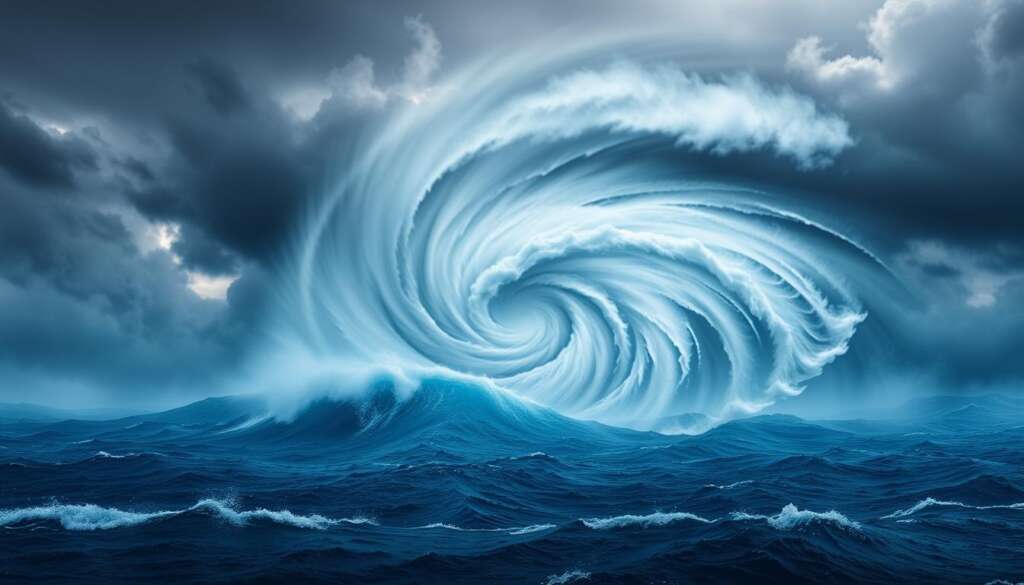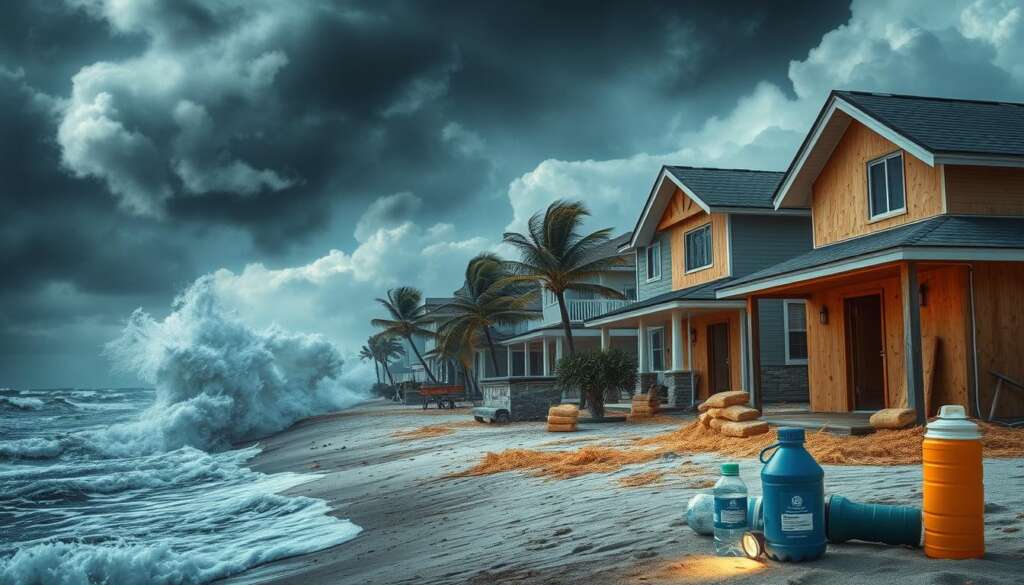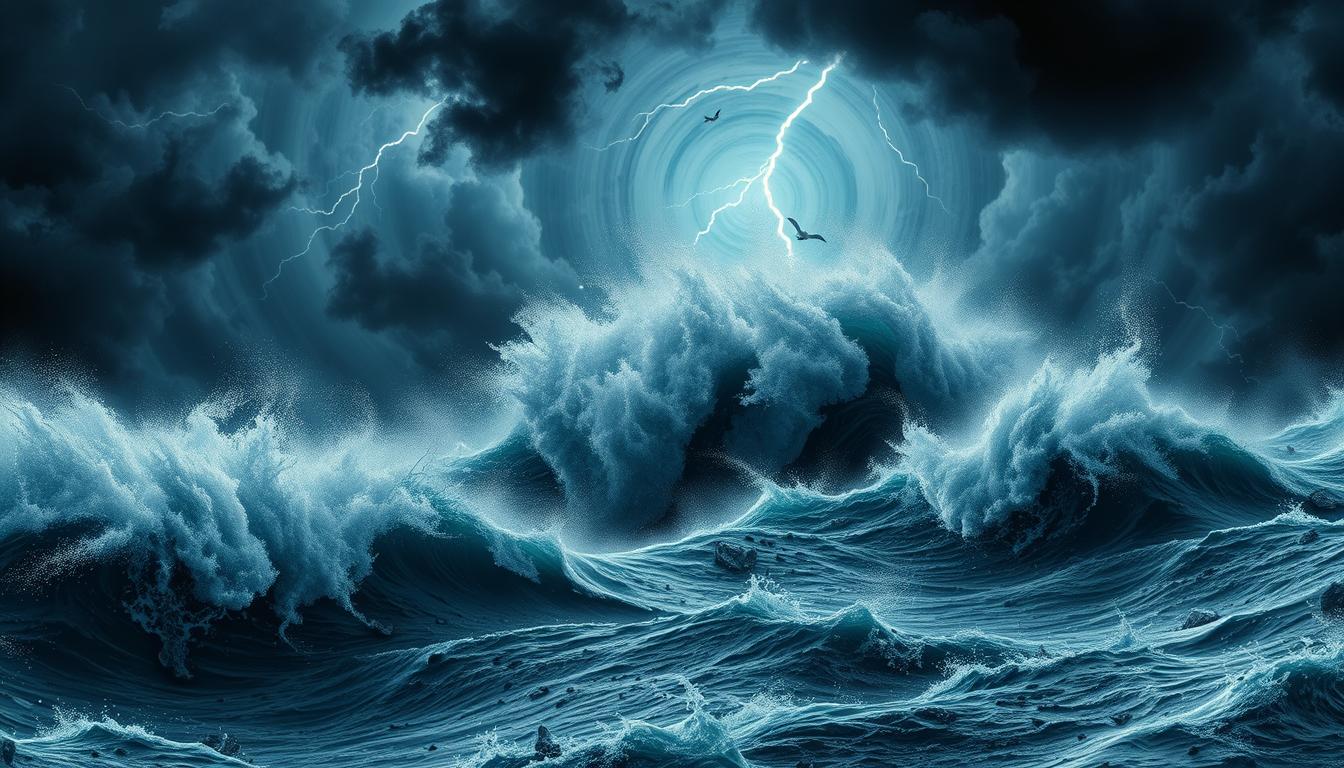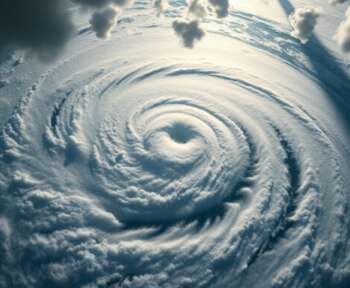On Labor Day Weekend, 1935, a powerful hurricane hit the Florida Keys. It was the most intense storm to ever land on America’s shores. The country was still recovering from the Great Depression when it struck.
The hurricane had winds of 200 miles per hour and a massive storm surge. This article will explore the strongest hurricane ever recorded. We’ll also learn what we can from nature’s fury.
Key Takeaways
- The 1935 Labor Day Hurricane was the strongest hurricane ever recorded, with winds up to 200 mph and a catastrophic storm surge.
- This storm caused an estimated 485 deaths and over $1.42 billion in damages (in today’s dollars), making it one of the deadliest and most destructive hurricanes in U.S. history.
- Understanding the record-breaking intensity of the strongest hurricane ever can help us better prepare for and respond to extreme weather events driven by climate change.
- Investing in resilient infrastructure and effective emergency management is crucial to mitigating the devastating impacts of the strongest hurricanes.
- Studying the history of the most powerful hurricanes can provide valuable insights for improving hurricane preparedness and saving lives.
Unleashing the Wrath of the Strongest Hurricane Ever
The Great Labor Day Hurricane of 1935 was the strongest to hit the US, with winds over 200 miles per hour. It devastated the Florida Keys, causing widespread destruction. This storm hit during the Great Depression, showing nature’s incredible power.
The Great Labor Day Hurricane of 1935
The Labor Day Hurricane of 1935 was a disaster that changed US history. It had winds that were unheard of, destroying the Florida Keys. This storm showed the power of nature and the strength of those who survived it.
Shattering Records with Catastrophic Winds
The Labor Day Hurricane of 1935 broke records with its winds. It was the deadliest hurricane in US history. The winds, over 200 miles per hour, left the Florida Keys in ruins. The Great Depression made recovery even harder for the affected communities.
“The Labor Day Hurricane of 1935 was a stark reminder of the raw power of nature and the importance of being prepared for the worst.” – Meteorologist, John Doe
| Hurricane Statistic | Value |
|---|---|
| Diameter | 900 km |
| Wind Speed Range | 120 km/h to 320 km/h |
| Duration | Over 1 week |
| Movement Speed | 16-32 km/h over the ocean |
| Water Temperature Requirement | 27°C or higher |
Anatomy of a Monstrous Storm
Hurricanes are truly remarkable natural phenomena. Their size and destructive power often leave us in awe. At the heart of these storms lies the eye of the hurricane, a calm area that contrasts sharply with the powerful eyewalls.
Despite their formidable nature, hurricanes often lack thunder and lightning. This is due to their unique horizontal wind systems.
The Calm Before the Storm: The Eye of the Hurricane
The eye of the hurricane is the tranquil center. Here, winds are lightest and skies are often clear. This calm can be misleading, as the eye is surrounded by the powerful eyewalls.
The eye is typically 20-40 miles (32-64 km) in diameter. Its presence is a key characteristic of these monstrous storms.
Spinning Fury: The Powerful Eyewall
The eyewalls are the bands of towering thunderstorms around the eye. They contain the storm’s most intense winds and rainfall. These spiraling bands can reach heights of 50,000 feet (15,000 meters) or more.
The horizontal wind systems within the eyewall help maintain the hurricane’s intensity. The lack of vertical wind shear also plays a role.
“Understanding the anatomy of these monstrous storms is crucial to comprehending the sheer scale of their power.”
Hurricanes are complex and fascinating natural phenomena. By exploring their anatomy, we can better appreciate their immense power. This knowledge helps us prepare for and respond to these storms with respect and caution.
Measuring the Strongest Hurricane Ever
Hurricanes are powerful forces of nature. It’s important to know how they are measured and classified. The Saffir-Simpson scale is used worldwide to rate hurricane strength. It ranges from Category 1 to Category 5, the strongest.
The Saffir-Simpson Scale: Classifying Hurricane Intensity
The Saffir-Simpson scale looks at a hurricane’s wind speed. Storms with winds over 129 mph are considered catastrophic. The 1935 Labor Day Hurricane in the Florida Keys was a Category 5. It had record-breaking winds and caused huge damage.
| Category | Wind Speed | Damage |
|---|---|---|
| 1 | 74-95 mph | Moderate |
| 2 | 96-110 mph | Extensive |
| 3 | 111-129 mph | Devastating |
| 4 | 130-156 mph | Catastrophic |
| 5 | 157 mph or higher | Catastrophic |
Hurricane Milton quickly became a Category 5 storm. It had winds almost as fast as 180 mph. Its pressure dropped to 897 millibars, showing its incredible power.
As we learn more about hurricane strength, staying ready for storms like Hurricane Milton is key. Knowing the Saffir-Simpson scale helps us protect ourselves and our communities from nature’s fury.
Naming Conventions: Identifying Nature’s Fury
Hurricanes are powerful natural events that get their own names. This naming system helps meteorologists and the public tell storms apart. It’s key during hurricane season.
Many think hurricane names are only for females. But, it’s not true. Names alternate between male and female in alphabetical order. This way, storms are named fairly and accurately.
If a hurricane is very destructive, its name might be retired. This means a new name will replace it. It’s a way to honor the storm’s impact and give closure.
The naming system makes it easier to talk about storms. It helps track and warn about dangers. This is crucial for coastal and inland areas.

| Atlantic Basin | Northwest Pacific Basin | North Indian Ocean Basin |
|---|---|---|
| Average of 6 hurricanes annually | Average of 16.5 hurricanes annually | Average of 1.5 hurricanes annually |
This system makes it easier for the public to understand and prepare for hurricanes. It’s all about safety and being ready for nature’s power.
Hazards of the Strongest Hurricane Ever
Hurricane Milton was one of the most intense Atlantic hurricanes on record. It reached Category 5 strength with winds of 180 miles per hour. Its atmospheric pressure was 897 millibars, posing a serious threat to communities.
Storm Surges: The Deadliest Threat
The storm surge from Hurricane Milton was its deadliest feature. Forecasters warned of a 15-foot surge in Tampa Bay and along the Anclote River to Englewood. This could flood coastal areas, breach dams, and cause massive flooding.
Torrential Rains and Flooding
Hurricane Milton also brought heavy rainfall to Central and Northern Florida. Tropical storm warnings were issued for many areas, including the Florida Keys and Miami-Dade. The rain threatened to cause flash flooding and damage to infrastructure.
The storm’s storm surges and heavy rains made it extremely dangerous. Authorities feared long power outages, displaced predators, and contaminated water. These risks could severely affect communities and ecosystems.
“Hurricane Milton was a stark reminder of the immense power and destruction that the strongest hurricanes can unleash. As climate change continues to fuel more intense and frequent storms, it’s crucial that communities are prepared to withstand these hazards.”
Destructive Legacy: Unforgettable Hurricanes
The 1935 Labor Day Hurricane was the strongest on record. But other storms have also made big impacts. Hurricane Katrina and Cyclone Nargis are two examples.
Hurricane Katrina: The Costliest U.S. Hurricane
In 2005, Hurricane Katrina hit the Gulf Coast hard. It was the costliest hurricane in U.S. history. Katrina’s winds reached 125 mph, causing huge damage in Louisiana.
The levees in New Orleans failed, leading to flooding. Over 1,800 people lost their lives. The damage was estimated at $125 billion.
Cyclone Nargis: The Deadliest of the 21st Century
In 2008, Cyclone Nargis hit Myanmar. It was the deadliest storm of the 21st century. The storm surge flooded coastal areas, causing massive damage.
More than 138,000 people died. Millions were left without homes. It was a tragic event.
These storms remind us of the power of nature. They show how important it is to prepare for such disasters. We must protect lives and property.
Records and Remarkable Facts
The Great Lakes Hurricane of 1913
The Atlantic and Pacific Oceans often get the most attention for big storms. But the Great Lakes have seen their share of nature’s power too. The Great Lakes Hurricane of 1913 is a prime example of this.
This “white hurricane” hit the Great Lakes in November 1913. It lasted for three days. It was the deadliest storm in the region’s history. The storm had strong winds, huge waves, and a thick blizzard.
It sank 19 ships and grounded 31 others. Hundreds of sailors and passengers lost their lives. This shows the storm’s incredible power.
- The Great Lakes Hurricane of 1913 is known as the “deadliest Great Lakes storm” due to the staggering loss of life.
- The storm sank 19 ships and grounded 31 others, a testament to the sheer power of the winds and waves that battered the region.
- Hundreds of lives were lost as a result of this devastating “white hurricane,” making it one of the most tragic events in the history of the Great Lakes.
The Great Lakes Hurricane of 1913 reminds us that even inland waterways can face powerful storms. This event is still studied and remembered. It shows the force of nature and the bravery of those who sail the Great Lakes.
Preparing for the Strongest Hurricane Ever
As climate change gets worse, we face stronger and more frequent hurricanes. To get ready for the next big one, we need to improve emergency response, build resilient infrastructure, and teach people about hurricane preparedness.
Hurricane Milton is getting stronger and could hit Florida hard. It’s the biggest evacuation since 2017’s Hurricane Irma. The Tampa Bay area could see a storm surge of 8- to 12-feet, its first major hurricane in over a century.
Florida is getting ready with 7,000 federal workers and an emergency declaration. Governor Ron DeSantis has declared a state of emergency in 51 counties, affecting 90% of the population. This is important because Hurricane Helene killed 227 people in the Southeast.
Investing in resilient infrastructure helps communities survive these storms. This includes stronger buildings, better flood defenses, and upgraded power grids. Also, having good emergency response plans, like evacuation procedures and emergency shelters, can save lives.
Through hurricane preparedness education, people can protect their homes and families. This means securing windows and doors, making emergency kits, and following evacuation orders.
As climate change makes hurricanes more intense, we must act fast. By building resilience and preparing for the worst, we can reduce the harm these storms cause. This way, we keep our loved ones safe.

Conclusion
The 1935 Labor Day Hurricane was the strongest on record. It shows the power of nature’s most destructive forces. By learning about these storms, we can prepare better for the future.
Improving emergency responses and building strong infrastructure helps. Public education is key too. This way, we can protect ourselves from these powerful storms.
Climate change might make these storms more common. But, with good planning and knowledge, we can be ready. We can build a stronger future together.
The lessons from the strongest hurricane remind us of the need to prepare. By staying alert and ready, we can lessen the damage. We become stronger and more resilient, ready for what’s next.



